Content marketing is the backbone of digital marketing. It’s not just a trend; it’s a strategic approach that empowers brands to connect with their audience through valuable, relevant, and consistent content. Whether you’re a business owner or a marketer, mastering content marketing in digital marketing can help build trust, educate customers, and ultimately drive sales. But what is content marketing exactly? Let’s dive into this foundational strategy and explore how it’s reshaping the way we market products and services in the digital space.
Table of Contents
What is Content Marketing?
At its core, content marketing is the creation and distribution of valuable content designed to attract, engage, and retain a clearly defined audience. Unlike traditional forms of marketing that focus on direct selling, content marketing centers on building a relationship with your audience through informative, entertaining, or inspiring content that addresses their needs or interests.
Content marketing is used in digital marketing to drive brand awareness, generate leads, boost conversions, and retain customers by positioning your brand as a trusted authority. With more and more consumers turning to the internet for information, advice, and entertainment, content marketing has become an essential tool for businesses to meet their customers where they are. In a nutshell, content marketing in digital marketing encompasses everything from blog posts and videos to social media posts, email newsletters, and infographics. It’s about providing value, establishing credibility, and nurturing long-term relationships with your audience.
Content Marketing vs. Digital Marketing: Key Differences
| Aspect | Content Marketing | Digital Marketing |
| Definition | Focuses on creating and distributing valuable content. | Encompasses all online marketing strategies and channels. |
| Primary Goal | Build brand awareness and nurture customer relationships. | Drive conversions and achieve business goals. |
| Focus | Involves blogs, videos, and other content types. | Includes SEO, PPC, email marketing, and more. |
| Scope | A subset of digital marketing, focusing solely on content. | A broader strategy that covers multiple digital channels. |
| Customer Engagement | Focuses on providing value through educational or entertaining content. | Utilizes various channels for immediate interaction and sales. |
| Time Frame | Long-term strategy for building relationships. | Can be short or long-term, often focusing on immediate results. |
| Measurement | Measures engagement, traffic, and brand sentiment. | Measures conversions, ROI, and sales. |
How Does Content Marketing Work?
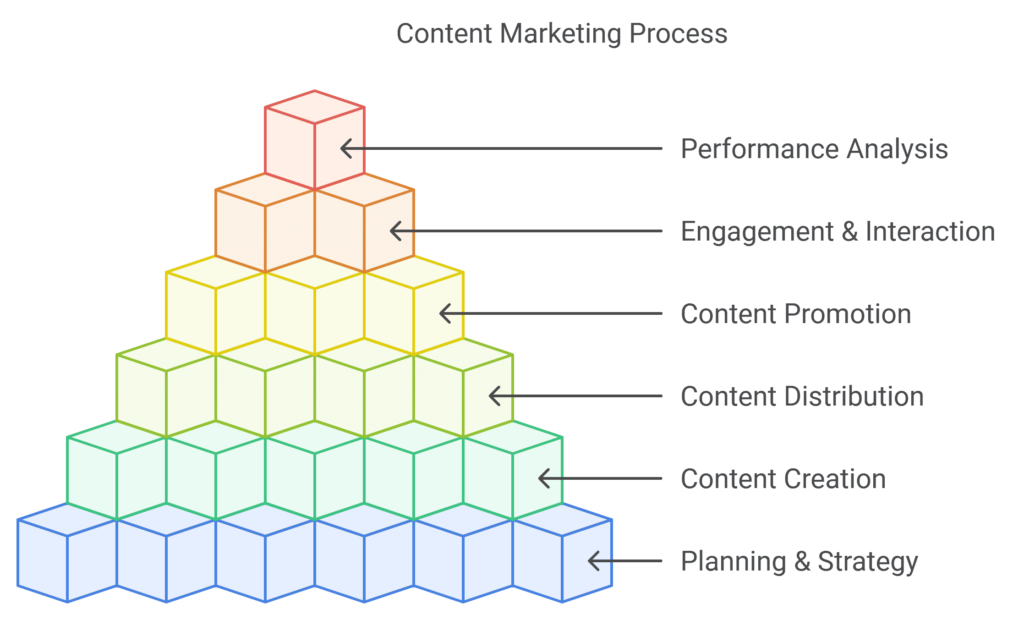
Content marketing is a strategic method focused on producing and sharing meaningful, pertinent, and consistent content to capture interest and engage a targeted audience. Its primary objective is to encourage profitable actions, such as conversions or sales, by offering content that informs, entertains, or addresses issues, instead of simply promoting a product or service. But how exactly does content marketing work? Let’s write it into its key components.
1. Planning and Strategy Development
The primary step in effective content marketing is planning. This phase involves identifying the objectives of your content marketing efforts and crafting a strategy that aligns with those goals. The primary objectives might include increasing brand awareness, generating leads, boosting engagement, or driving conversions.
During this phase, businesses typically:
- Define their audience: Understanding who your target audience is—what their needs, interests, and pain points are—is crucial for creating relevant content.
- Set measurable goals: Establish clear KPIs (Key Performance Indicators) like increased web traffic, higher engagement rates, or more leads to track the success of your campaigns.
- Choose content formats: Based on your audience and goals, decide which types of content will resonate best—blog posts, videos, infographics, podcasts, etc.
- Create a content calendar: Developing a content calendar helps ensure that you consistently publish content and stay on track with your content goals.
2. Content Creation
Once the strategy is in place, it’s time to create the content. High-quality content is the cornerstone of successful content marketing, as it serves to educate, inform, or entertain your target audience. This step involves:
- Research and Topic Selection: Content creation starts with understanding the topics that matter most to your audience. Keyword research tools, audience surveys, and competitor analysis can provide insights into the topics and questions your audience is searching for.
- Crafting the Content: The content itself should offer value. Whether it’s blog posts, videos, or infographics, the key is to provide something that helps solve a problem or answer a question for the reader. It’s important to keep the tone and voice consistent with your brand’s identity. However, if you feel like you missed the tonal consistency aspect, then consider rephrasing sentences with a reliable reword generator tool to adjust sentences to match the desired tone quickly.
- Incorporating SEO: Content should be optimized for search engines to help it reach a wider audience. This includes using relevant keywords, meta tags, and proper formatting to improve search rankings. Well-optimized content is more likely to appear in search results, increasing visibility and driving organic traffic.
3. Content Distribution
Creating great content is just the beginning; it’s essential to ensure that your audience sees it. Content distribution involves delivering your content to the right audience at the optimal moment. You can use various channels to distribute content, including:
- Website: Posting content directly to your website (e.g., blog articles or case studies) provides a centralized place where people can learn about your brand.
- Social Media: Sharing content on platforms like Facebook, Instagram, LinkedIn, and Twitter can significantly extend your content’s reach. Social media allows you to engage with your audience directly, respond to questions, and encourage conversations.
- Email Marketing: Email campaigns are an effective way to share new content directly with your subscribers. By including your latest blog posts, case studies, or special offers, you can keep your audience engaged and informed.
- Third-party Platforms: Distributing content via guest posts on other websites or through partnerships can help extend your reach even further. Platforms like Medium, LinkedIn Pulse, or industry-specific sites can increase the visibility of your content.
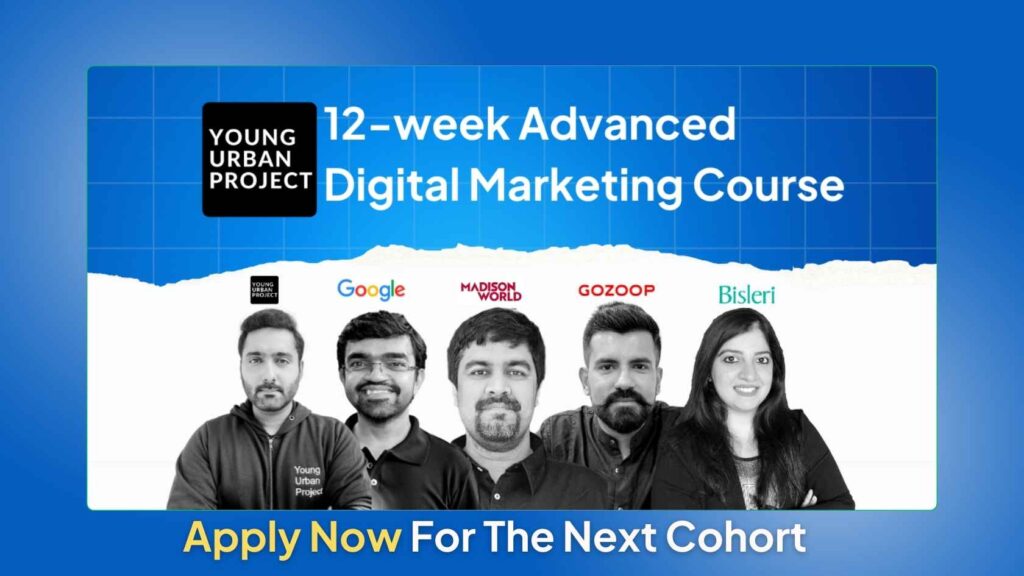
4. Content Promotion
After distributing your content, the next step is promotion. This involves techniques that help your content gain more visibility, reach a larger audience, and ultimately drive traffic or leads. Promotion can take many forms:
- Paid Advertising: Platforms like Google Ads, Facebook Ads, or native advertising can amplify your content’s reach by putting it in front of a highly targeted audience.
- Influencer Marketing: Collaborating with influencers who have large followings can help expose your content to a new, relevant audience.
- SEO: Optimizing your content for search engines is one of the most effective promotional strategies. The more optimized your content is, the more likely it is to rank highly in organic search results, driving more traffic to your site.
Also Read: Performance Marketing Online Training
5. Engagement and Interaction
Content marketing is not just about pushing out content—it’s also about fostering interaction and engagement. Engagement can occur in various ways:
- Comments: Encourage your readers to leave comments on your blog posts or social media pages. Responding to comments helps create a community and establish your brand as approachable and trustworthy.
- Social Sharing: Content that resonates with your audience is often shared across social media platforms. This increases your reach, allowing your content to go viral and attract new potential customers.
- Polls and Surveys: Using interactive content such as polls, quizzes, or surveys can help engage your audience and gain valuable insights into their preferences and opinions.
6. Analyzing Performance and Optimizing
The final step in the content marketing process is evaluating its effectiveness. It’s important to monitor key performance metrics to understand how your content is performing and whether it’s helping achieve your goals. Metrics to track include:
- Traffic: The number of visitors who came to your website or interacted with your content across social media.
- Engagement: Metrics like shares, likes, and comments can show how well your audience is connecting with your content.
- Lead Generation: Track the number of leads (such as email sign-ups or downloads) that are generated from your content.
- Conversion Rate: Measure how many visitors completed the desired action, such as making a purchase or filling out a contact form.
Importance of Content Marketing
1. Builds Brand Awareness and Authority
In the crowded digital world, visibility is key. Without being seen, even the best products or services may fail to reach their potential customers. Content marketing serves as a powerful tool to increase brand awareness by allowing businesses to show up where their target audience is already searching for information, entertainment, or solutions.
2. Drives Traffic and SEO Benefits
Content marketing and Search Engine Optimization (SEO) go hand-in-hand. By creating high-quality, keyword-optimized content, you increase the chances of your website appearing higher on search engine results pages (SERPs). This means more people will find your business when they search for terms related to your products, services, or industry.
3. Nurtures and Engages Customers
Content marketing is also one of the best ways to build relationships with your audience. Furthermore, 63% of marketers believe content marketing plays a key role in nurturing leads, while 50% report that it helps foster loyalty among existing customers.
Unlike traditional advertisements that focus on immediate sales, content marketing focuses on nurturing leads over time. Through engaging, educational, or entertaining content, you can keep your audience interested in your brand long before they’re ready to make a purchase.
Regularly publishing content also keeps your brand active in the minds of your audience, encouraging them to return for more. Over time, this engagement turns into stronger customer relationships, which ultimately results in repeat business and word-of-mouth recommendations.
4. Generates Leads and Boosts Conversion Rates
While content marketing is often associated with brand awareness and engagement, its impact on lead generation and conversions cannot be underestimated. According to 76% of marketers, content marketing is responsible for generating demand and leads.
By offering valuable content—such as free eBooks, downloadable guides, or in-depth blog posts—businesses can capture leads through calls-to-action (CTAs) that encourage users to provide their contact details.
Not only does content marketing attract leads, but it also helps to nurture them into becoming customers. A comprehensive content strategy will focus on delivering the right message at the right time throughout the buyer’s journey, guiding them from awareness to consideration and, ultimately, to conversion.
5. Establishes Trust and Credibility
In the digital era, consumers are more cautious about who they do business with. They have access to information at their fingertips, and they expect transparency and authenticity from the brands they interact with. Content marketing allows brands to earn the trust of their audience by providing valuable, relevant, and informative content over time.
When you create content that addresses your audience’s concerns or provides helpful solutions, you’re not just promoting a product—you’re building a relationship. Whether it’s through blog posts, videos, podcasts, or social media, each piece of content helps to demonstrate your expertise, improve your credibility, and establish trust.
6. Enhances Customer Retention
Content marketing is not just about attracting new customers—it’s also about keeping existing ones engaged and satisfied. A great way to ensure customer loyalty is to continue providing value through content even after a sale has been made.
Regularly sharing relevant content with your customers, such as product updates, how-to guides, loyalty rewards, and exclusive offers, can help maintain a strong relationship.
By nurturing customers post-purchase, you increase their lifetime value and likelihood of becoming repeat buyers. Satisfied customers are also more likely to refer friends and family, further expanding your reach and building brand loyalty.
7. Cost-Effective Marketing Strategy
When compared to traditional marketing methods such as television ads, radio spots, or print media, content marketing is relatively cost-effective. Creating and distributing digital content is generally less expensive than running paid advertising campaigns, especially when you consider the long-term benefits.
Instead of paying for each lead or conversion (as you would with paid ads), content marketing focuses on providing long-lasting value. High-quality content, once published, can continue to attract organic traffic and generate leads for months or even years, offering a strong return on investment (ROI).
Moreover, content marketing can be scaled according to your needs. Small businesses or startups can produce content at a lower cost, while larger organizations with more resources can expand their content marketing efforts across multiple channels to reach a broader audience.
8. Competitive Advantage
In many industries, businesses are competing for the same customer base. Content marketing can give you a competitive edge by differentiating your brand and offering something your competitors aren’t. For example, while many brands might advertise their products in the same way, a brand that offers unique, informative content can stand out by providing additional value to its customers.
By staying on top of current trends, addressing emerging customer needs, and producing high-quality content consistently, you can carve out a niche for your business and make it the first choice for your target audience.
Types of Content Marketing
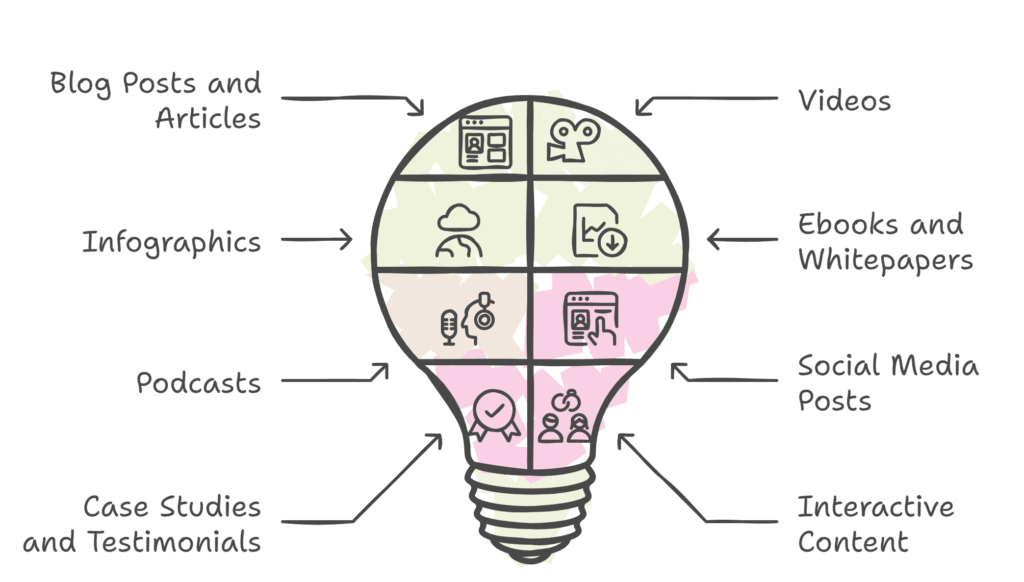
1. Blog Posts and Articles
Blogging remains one of the most powerful and widely used types of content marketing. Blogs allow businesses to share valuable insights, updates, and tips regularly, positioning the brand as an authoritative voice in the industry.
How to Use It:
- Regularly publish informative articles that address your audience’s pain points.
- Use a combination of long-form content for in-depth discussions and short-form content for quick insights.
- Optimize your blog posts with relevant keywords and a strong call to action (CTA).
2. Videos
Video content is one of the most engaging and powerful tools in content marketing. With the rise of platforms like YouTube and Instagram, videos are a versatile medium for reaching a broad audience. From explainer videos to behind-the-scenes glimpses, videos can captivate audiences in ways that text alone cannot.
How to Use It:
- Create product demos, tutorials, or “how-to” videos to showcase your products or services.
- Share customer testimonials or success stories through video interviews.
- Use platforms like YouTube, Instagram, or Vimeo to host and share your videos.
3. Infographics
Infographics combine data, visuals, and text to present complex information in a simple and digestible format. They are a visually appealing way to convey statistics, processes, or concepts, making them perfect for audiences who prefer quick, easy-to-understand content.
How to Use It:
- Create infographics that highlight key industry statistics or explain complicated concepts in a simplified format.
- Share infographics on social media, blogs, and your website.
- Ensure your infographics are branded and contain clear data to build trust with your audience.
4. Ebooks and Whitepapers
Ebooks and whitepapers are more in-depth content formats that allow businesses to go beyond blog posts and provide detailed insights on complex topics. These types of content are typically longer and more comprehensive, and they’re often used in lead-generation efforts.
How to Use It:
- Offer an ebook or whitepaper in exchange for email subscriptions or contact information.
- Use these content pieces to explain industry trends, provide case studies, or offer solutions to common challenges.
- Promote your ebooks and whitepapers through landing pages, email campaigns, and social media.
5. Podcasts
Podcasts are an increasingly popular content format that allows businesses to create audio content that their audience can listen to on the go. Podcasting is a great way to share insights, interview experts, and build a loyal following by offering valuable, easily accessible content.
How to Use It:
- Launch a podcast series around topics relevant to your audience and your industry.
- Use podcasts to interview industry leaders, discuss trends, or dive deep into specific topics.
- Promote your podcast episodes through email, social media, and your website.
6. Social Media Posts
Social media is a key content distribution channel that allows businesses to directly engage with their audience. Platforms like Facebook, Instagram, Twitter, and LinkedIn allow businesses to share content, interact with followers, and build a community around their brand.
How to Use It:
- Share blog posts, infographics, videos, and other content types on your social media profiles.
- Use platform-specific features, like Instagram Stories, Twitter threads, or LinkedIn articles, to engage with followers.
- Interact with followers by responding to comments, asking questions, and encouraging user-generated content.
7. Case Studies and Testimonials
Case studies and customer testimonials are powerful content marketing tools that provide social proof and build trust with potential customers. These content pieces show how your product or service has successfully helped real clients, adding credibility to your brand.
How to Use It:
- Create in-depth case studies that show how your product or service helped solve a specific problem or achieve a measurable result.
- Share customer testimonials across your website, social media, and email campaigns.
- Include case studies on your landing pages to increase conversion rates.
Important Metrics to Track Content Marketing Efforts
To evaluate the effectiveness of your content marketing, it’s essential to track key metrics. Here are some important ones to monitor:
1. Website Traffic (Overall Visits and Page Views)
Why It Matters:
Website traffic is one of the most fundamental metrics for measuring content performance. Increased traffic means more people are discovering your brand, engaging with your content, and potentially entering your sales funnel. Monitoring traffic gives you a clear indication of how well your content is attracting new visitors.
Key Insights:
- Organic Traffic: Shows how well your content is performing in search engines, driving visitors to your site without paid ads.
- Referral Traffic: Indicates the effectiveness of your content in driving traffic from other websites, including backlinks and social media shares.
- Direct Traffic: Tracks people who visit your site directly, often due to brand recall after engaging with your content.
How to Track:
Use tools like Google Analytics, SEMrush, or Ahrefs to monitor how many people visit your site, which pages they visit, and how they found you.
2. Engagement Metrics (Time on Page, Bounce Rate, and Pages per Session)
Why It Matters:
Engagement metrics tell you how well your content resonates with your audience. If people are spending time on your page, reading your articles, or watching your videos, it indicates that your content is engaging and providing value. Conversely, a high bounce rate can signal that users are not finding what they expected, prompting a need for content optimization.
Key Insights:
- Time on Page: The longer users stay on your content, the more likely they are to absorb your message, and the more engaged they are with your brand.
- Bounce Rate: A high bounce rate (users leaving without interacting with other pages) often means your content isn’t meeting expectations or that your landing page needs improvement.
- Pages per Session: This shows how many pages visitors navigate through during a session, indicating whether your content is compelling enough to make them explore more.
How to Track:
Again, Google Analytics provides detailed insights into how long people stay on your pages, how many pages they view, and if they bounce right away.
According to a Content Marketing Institute (CMI) study, articles with higher engagement rates (longer average time on page) see a 55% higher conversion rate than those with lower engagement.
3. Conversion Rate (Leads and Sales Generated from Content)
Why It Matters:
At the end of the day, content marketing aims to drive conversions—whether that means filling out a lead form, signing up for a newsletter, or making a purchase. Tracking conversion rates is crucial for determining the direct impact your content has on your business goals.
Key Insights:
- Lead Generation: For many businesses, the primary goal of content is to generate leads by enticing visitors to exchange their contact information in return for something valuable, like an ebook, webinar, or case study.
- Sales Conversions: If you are selling directly through content (e.g., through a product demo or landing page), measuring sales generated by content will give you clear insights into ROI.
How to Track:
Use conversion tracking in tools like Google Analytics or HubSpot. These tools allow you to set goals for specific actions, such as form submissions or purchases, and track how well your content contributes to these conversions.
4. Social Shares and Social Engagement (Likes, Comments, Shares)
Why It Matters:
Social media is a significant distribution channel for content. Tracking how often your content is shared, liked, and commented on is a great way to measure its virality and the level of engagement it generates across platforms. If your content resonates with your audience, they will naturally share it with their network, amplifying your reach.
Key Insights:
- Shares and Likes: Indicates how appealing your content is to your audience and whether they find it worth sharing with their social circles.
- Comments and Mentions: Shows deeper engagement, as users are taking the time to express their thoughts or ask questions about your content.
- Follower Growth: A steady increase in followers as a result of your content suggests that people are not just liking and sharing—it’s making them want to stay connected with your brand.
How to Track:
Social media management tools like Hootsuite, Buffer, or Sprout Social allow you to track shares, likes, and comments across multiple platforms.
5. SEO Metrics (Keyword Rankings and Organic Search Traffic)
Why It Matters:
A significant portion of content marketing focuses on creating content that ranks well in search engines. Monitoring keyword rankings and organic search traffic allows you to measure how successful your content is at being discovered by your target audience through search queries.
Key Insights:
- Keyword Rankings: Tracks how well your content ranks for target keywords, a critical component of SEO success.
- Organic Search Traffic: Indicates the amount of traffic your content receives from search engines, demonstrating whether your content is appearing in search results and attracting users organically.
How to Track:
Tools like Google Search Console, Ahrefs, and SEMrush help track keyword rankings and provide detailed reports on how your content is performing in search.
6. Return on Investment (ROI) and Cost per Acquisition (CPA)
Why It Matters:
While the qualitative benefits of content marketing (brand awareness, engagement, etc.) are important, businesses must also measure the financial impact of their efforts. ROI helps you understand how much revenue your content is generating in relation to the costs involved in creating and distributing it. CPA helps you understand how much it costs to acquire a new customer via content marketing channels.
Key Insights:
- ROI: A high ROI means your content marketing efforts are delivering good returns, justifying the budget spent on content creation, distribution, and promotion.
- CPA: Lower CPA means you’re acquiring customers more efficiently, and it often indicates that your content is well-targeted and effective in guiding prospects through the funnel.
How to Track:
Track your content’s revenue impact through tools like Google Analytics (using eCommerce tracking or goal tracking) or HubSpot, which integrates marketing and sales data to calculate ROI.
A 2023 Content Marketing Institute (CMI) study found that 72% of B2B marketers said content marketing improved their ROI and helped them lower customer acquisition costs significantly.
7. Customer Feedback and Sentiment
Why It Matters:
Beyond quantitative metrics, listening to your customers’ feedback and sentiment about your content provides invaluable insights into how your audience perceives your brand. Positive sentiment can lead to brand loyalty, while negative sentiment can highlight areas where your content might be missing the mark.
Key Insights:
- Customer Sentiment: By tracking how customers feel about your content, whether through surveys, social media mentions, or reviews, you can gauge the overall impact of your content marketing efforts.
- Customer Feedback: Direct feedback from your audience—whether through comments, emails, or surveys—provides actionable insights into what works and what doesn’t.
How to Track:
Monitor customer sentiment using social listening tools like Brandwatch, Mention, or Hootsuite Insights. Additionally, conduct regular customer surveys or review your content’s comment sections for direct feedback.
According to a 2023 survey, businesses that actively track and respond to customer feedback on their content experience 18% higher customer satisfaction rates.
How to Build Content Marketing Strategies
Creating an effective content marketing strategy involves several key steps:
- Define Your Goals: Are you trying to generate leads, increase brand awareness, or drive traffic? Your goals will guide your content strategy.
- Know Your Audience: Develop detailed buyer personas to understand your audience’s interests, pain points, and challenges.
- Choose the Right Content Type: Select the formats that resonate most with your audience. Blog posts might work well for educational content, while videos might be better for demonstrations.
- Content Calendar: Plan a content calendar to ensure consistency and coverage of all relevant topics.
- SEO Optimization: Ensure your content is optimized for search engines by including relevant keywords, meta tags, and internal linking.
- Promotion Plan: Create a plan for promoting your content across social media, email, paid ads, and other channels.
- Analyze and Optimize: Continuously measure your results and optimize your strategy based on data.
Examples of Content Marketing
HubSpot’s Blog: HubSpot’s blog is an excellent example of content marketing. It provides helpful, informative content on marketing, sales, and customer service, attracting millions of monthly visitors and establishing HubSpot as a leader in its field.

Zomato: Zomato’s social media presence is another example of effective content marketing. The brand has mastered the art of mixing fun, engaging, and sometimes humorous content with its core business objective of food delivery and discovery. Zomato’s social media strategy includes a variety of content forms—ranging from memes to food reviews, polls, and interactive content—that resonate with a wide audience.
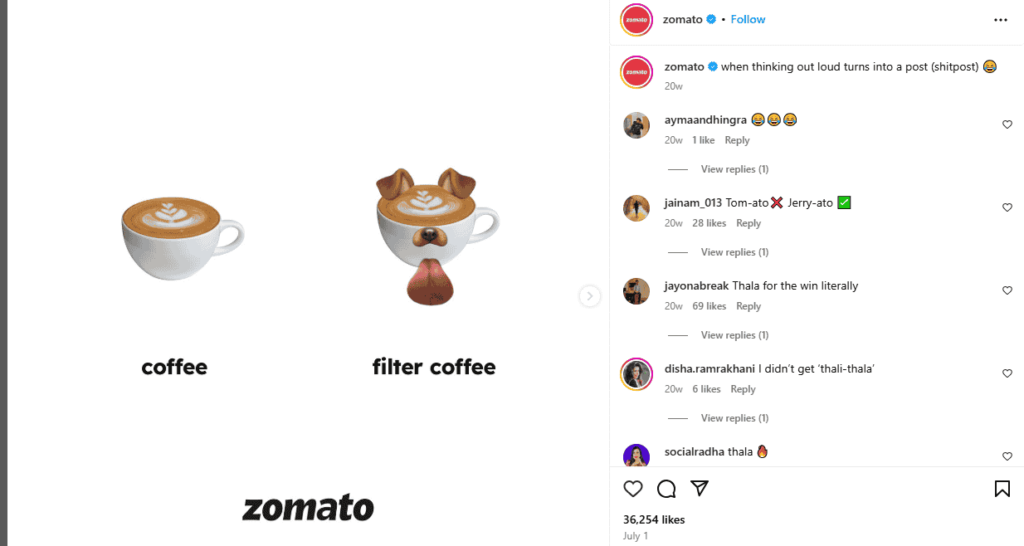
Moz’s Whiteboard Friday: Moz’s Whiteboard Friday series is a great example of how educational content can build authority. It provides valuable insights into SEO, helping Moz attract and engage its target audience while promoting its software.
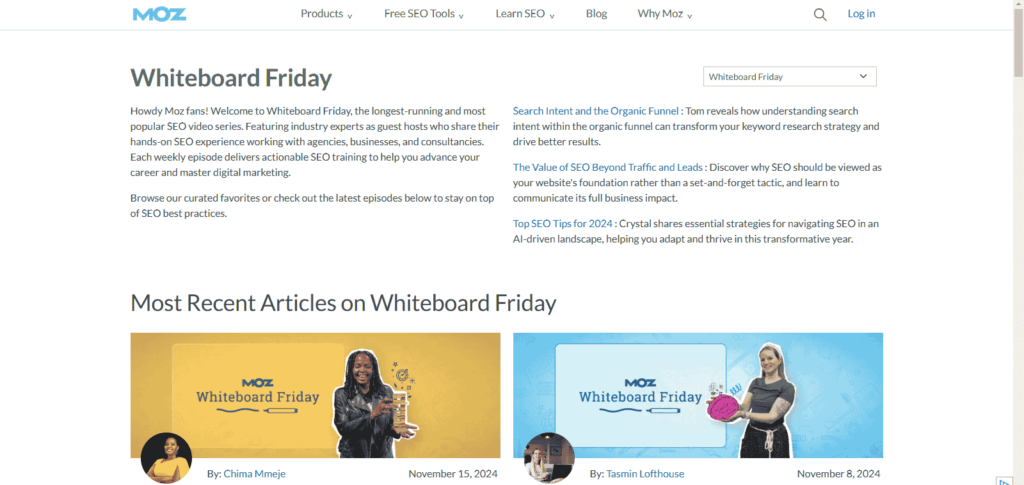
Conclusion
Content marketing is one of the most powerful tools in digital marketing. By providing valuable, relevant, and consistent content, businesses can build trust, drive traffic, generate leads, and nurture long-lasting relationships with customers. By understanding how content marketing works, applying the right principles, and tracking your efforts, you can ensure your content marketing strategy delivers impressive results. Start creating valuable content today, and watch your digital marketing efforts grow!
FAQs: What is Content Marketing?
What is the main goal of content marketing?
The main goal of content marketing is to attract and engage your target audience by providing valuable, relevant, and consistent content. The idea is to build trust and authority over time so that your audience sees you as a go-to resource in your field. This trust ultimately encourages them to take profitable actions, like purchasing your products, signing up for your services, or becoming loyal advocates for your brand. Content marketing isn’t about direct selling; it’s about creating a long-term relationship with your audience by addressing their needs, solving their problems, and adding value to their lives.
How long should my content be for it to be effective?
The ideal content length depends on your goals, audience, and format. For blog posts, studies show that long-form content—typically over 1,000 words—tends to perform better for SEO because it provides in-depth information that satisfies search intent. However, quality should always take precedence over word count. A concise, well-researched 800-word article can be just as effective if it directly answers your audience’s questions. For social media, shorter content that’s clear and impactful works best. Ultimately, focus on creating content that’s as long as it needs to be to inform, engage, and inspire your audience.
How do I know if my content marketing efforts are working?
The best way to measure the success of your content marketing is through data and analytics. Start by tracking key performance indicators (KPIs) such as:
–Website traffic: Is your content bringing more visitors to your site?
–Engagement rates: Are people reading, liking, sharing, or commenting on your content?
–Lead generation: Is your content converting readers into leads or subscribers?
–Conversions: Are those leads turning into paying customers or taking the desired actions?
Use tools like Google Analytics, HubSpot, or social media insights to monitor these metrics. If you notice steady growth or improvement in these areas, it’s a sign that your content marketing strategy is working. Regularly review your data to identify what’s performing well and what needs tweaking.
How often should I publish content?
Consistency is more important than frequency when it comes to publishing content. Whether you post once a week, bi-weekly, or monthly, stick to a schedule that you can maintain over the long term. Regularly publishing fresh content keeps your audience engaged, helps with SEO, and builds trust. Consider the preferences of your audience—if they prefer in-depth articles, fewer but higher-quality posts may be better. For platforms like social media, where content consumption is faster, posting multiple times a week or even daily might make sense. The key is finding a balance that aligns with your resources and audience expectations.
Can small businesses benefit from content marketing?
Absolutely! Content marketing can be a game-changer for small businesses. It allows you to compete with larger companies by focusing on building relationships, trust, and authority in your niche. Through blogs, social media, videos, or newsletters, you can showcase your expertise and offer solutions to your audience’s problems. The best part? It doesn’t require a massive budget. A single well-written article or an engaging video can have a lasting impact. For small businesses, content marketing is a cost-effective way to increase brand awareness, drive organic traffic, and build a loyal customer base without relying heavily on paid advertising.

